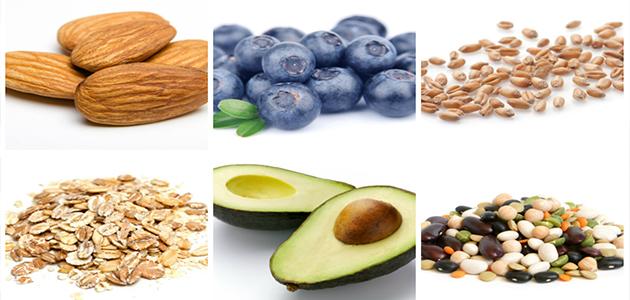Contents
- 1 Malnutrition
- 2 types of malnutrition
- 3 causes of malnutrition
- 4 People most vulnerable to malnutrition
- 5 manifestations of malnutrition
- 6 Diagnosis of malnutrition
- 7 ways to prevent malnutrition
- 8 Solve the problem of malnutrition
- 9 complications of malnutrition
- 10 common questions about malnutrition
- 11 References
Malnutrition
The World Health Organization , or what it stands for in short by WHO, defines the term malnutrition as a decrease, an increase in the body's intake of nutrients, an imbalance of basic nutrients , or a poor use, and is considered Undernutrition and overweight are among the main types of malnutrition, in addition to obesity, and other non-communicable diseases associated with diet. It should be noted that undernutrition has many forms. , Which; Wasting, being underweight or underweight, stunting, and deficiency of micronutrients are further explained in the article. [1]
It is worth noting that billions of people around the world suffer from malnutrition, and some face severe risks as a result of the development of some types, and these risks vary according to lifestyle, the surrounding environment, in addition to the available resources. [2] The World Health Organization indicated in a report it published in 2019. Noting that more than a third of low- and middle-income countries suffer from overlapping types and forms of malnutrition, [3] the degree of suffering from malnutrition may range from mild to severe and life-threatening, and malnutrition can result from a state of extreme hunger ; This is when insufficient quantities of calories are consumed , and it is interesting that the phenomenon of malnutrition is a major global problem, especially in developing countries. [4]
Types of malnutrition
Malnutrition can appear in several types, and they are as follows:
- Undernourishment: which is divided into four main forms, namely: [5]
- Wasting Which usually is a sudden and severe weight loss, as a result of not eating enough quantities of food, or having an infectious disease; Diarrhea , or both, which causes a decrease in weight in relation to height.
- Stunting, or lack of growth ; Where in this case appears a lack of height for age; This is a result of chronic or recurring nutritional deficiencies, and this is often due to many reasons, such as: poor social and economic conditions, repeated infection with a specific disease, poor mother’s health and nutrition, inappropriate nutrition and care for the child in his early stages of life, or all of the aforementioned It is worth noting that stunting reduces children's ability to achieve proper growth, both physically and cognitively.
- Weight loss It is a condition represented by the low weight of the child for his age, and he may suffer alongside it from stunting, wasting, or both.
- Malnutrition associated with the level of micronutrients: This type of malnutrition appears in two different forms, namely; Micronutrient deficiencies are deficient or increased (micronutrient excess). Minerals and vitamins are referred to as micronutrients that enable the body to produce hormones, enzymes, and other basic substances necessary for the proper development and growth, for example. Iodine, vitamin A, and iron are among the most important nutrients. Their deficiency threatens the health of people around the world, especially children and pregnant women in low-income countries.
- Secondary nutritional deficiency: as this type is not related to diet; Rather, it occurs as a result of infection with some diseases that prevent the body from absorbing nutrients, and among these diseases: Diarrhea, infection, measles , and others, as it can occur as a result of exposure of the body to pathogens; Such as intestinal parasites, and so on. [6]
- Hypernutrition : overeating It is the consumption of food in large quantities compared to the body's need, despite its wide spread in the past in the developed world; However, it is now appearing in countries with emerging economies. [6]
Causes of malnutrition
The following points explain some of the causes that lead to malnutrition: [7]
- Lack of food; This is common among low-income people and the homeless.
- Difficulty eating As a result of dental pain, or suffering from painful mouth lesions.
- Dysphagia, and its difficulty.
- Anorexia; And this depends on a range of reasons, such as: cancer, tumors, liver or kidney disease, chronic infection, in addition to depression , and other mental disorders, and so on.
- Eating disorders; Such as anorexia nervosa. People who contract it do not get adequate nutrition.
- Have diarrhea, persistent vomiting, or nausea.
- Mental health disorders; Depression, and others, as a study published in the Iranian Journal of Public Health in 2011 and conducted on the elderly indicated that the prevalence of malnutrition was 4% higher among those with depression compared to healthy people. [8] [2]
- Inability to obtain and prepare food; An observational study published in the Journal of Nursing Scholarship in 2017 on the elderly showed that poor body structure, muscle strength and strength, in addition to difficulty with movement, are factors that impair food preparation skill, and thus increase the risk of malnutrition. [9] [2]
- Food insecurity, or the inability to obtain adequate or affordable food; Research has indicated that these factors are related to the risk of malnutrition in children, adults and the elderly, as mentioned in an observational study published in the Journal of Health Economics in 2004 [10] and another published in the American Academy of Pediatrics in 2006, among others. [11] [2]
- Infection with diseases in the digestive system, and disturbances in the absorption of food; Crohn's disease , bacterial overgrowth in the intestine, and celiac disease . [2]
- Excessive alcohol consumption, which may cause insufficient amounts of protein, micronutrients, etc., is associated with an increased risk of malnutrition. [2]
- Excessive consumption of food rich in calories; Such as fats, carbohydrates, or proteins compared to the body's need, which leads to the accumulation of excess quantities in the body in the form of fats, which in turn cause weight gain if the level of physical activity is not improved. [12]
- Excessive consumption of micronutrients; This is usually done by consuming large quantities of nutritional supplements, as it is rare to obtain these quantities through food only, and it should be noted that excessive intake of these nutrients; Eating a large amount of iron tablets at once can cause severe poisoning. [12]
People most vulnerable to malnutrition
Different persons are considered vulnerable to developing malnutrition, but it is more prevalent among the following groups: [13]
- People with long-term health problems that affect appetite, weight, or nutrient absorption in the intestine, or all together; Crohn's disease.
- People with dysphagia.
- People with limited income, or those who are socially isolated, or who suffer from difficulty in moving and moving.
- Those who need to consume more calories, such as: cystic fibrosis patients, those recovering from serious injuries and burns, and tremors .
- Elderly people aged 65 and over.
- Those who depend on their nutrition on others and thus are more likely to suffer from primary malnutrition, such as: infants, the elderly, prisoners, children, and people with physical or mental disabilities. [14]
- Those suffering from eating disorders; As they may be more susceptible to secondary malnutrition, and these disorders occur as a result of problems with digestion, or absorption of nutrients, or their use in the body, and moreover, cancer, eating disorders, tuberculosis , and AIDS, in addition to To surgeries can affect the appetite, or the absorption of food; Which leads to malnutrition. [14]
Manifestations of malnutrition
The manifestations and symptoms associated with malnutrition are numerous, including the following: [15] [16]
- Loss of appetite, or decreased desire to consume food and drink.
- Fatigue and irritability
- Inability to concentrate.
- Persistent feeling of cold.
- Depression.
- Decreased muscle mass, body tissue, and fat loss.
- The higher the risk of disease, the longer the recovery time.
- The need for a longer recovery period when injured.
- High risk of complications after surgery.
- Hair breakage.
- Slow growth.
- Flatulence
- skin dryness.
- Fatigue.
- Headache .
- Cracked nails.
- Obesity, being overweight or underweight.
- Peeling of the skin.
- Impaired immune system function.
- Short stature.
- Swelling of the limbs.
Diagnose malnutrition
There are many methods that a specialized doctor uses to diagnose malnutrition, as he can check height and weight, and he may ask about the meals you eat. This is to ensure that you are getting adequate nutrients and calories, and the doctor may also order several blood tests. To detect a deficiency in some nutrients in the body. [17]
It should be noted that a simple examination can be performed by measuring the Mid Upper Arm Circumference, or MUAC. Which determines whether the patient suffers from thinness, in addition to that the doctor can confirm the presence of symptoms of water retention in the body, changes in hair and skin color, flatulence, and an enlarged liver. [14]
Methods for preventing malnutrition
Care must be taken to provide the body with various nutrients by eating a variety of foods to prevent malnutrition, and some groups should; As the elderly, children, and people with severe or chronic diseases, make sure that they get the nutrients they need, and it is recommended to see a specialist doctor by those who show signs of malnutrition, or lack thereof, [15] and with regard to countries suffering from the problem of malnutrition; It is a matter of helping them to develop appropriate systems and programs for evaluation and monitoring. [18]
It is worth noting that a healthy and balanced diet, which is recommended to reduce the risk of malnutrition, consists of the following four main food groups: [19]
- Bread, rice, potatoes and other starches; These varieties contain a large amount of calories that provide the body with energy, in addition to carbohydrates that are converted into sugar needed to produce energy as well.
- Milk and dairy products; Where these foods provide the body with fats, and simple sugars; Calcium lactose, in addition to various minerals. Calcium.
- fruits and vegetables; It is a major source of vitamins and minerals, in addition to dietary fiber that promotes the health of the digestive system.
- Meat, poultry, fish, eggs and other sources of protein ; As it is a basic building block of the body, and helps to perform many of its functions, as well as the functions of various enzymes.
Solve the problem of malnutrition
The treatment of the problem of malnutrition depends on the main cause of it, and the way in which the person suffers from this problem, and accordingly, the patient may need to follow the advice and instructions from a nutritionist or a specialist doctor, as well as receive care and support at home through members of the house, and the matter may require follow-up Hospitalization; And in severe cases, the following is an explanation of some suggested solutions to malnutrition: [13] [20]
- Treatment at home: Some methods are followed at home to obtain the appropriate treatment for malnutrition, including the following:
- Changing the diet, and the use of supplements: A dietitian can suggest some changes to the patient's diet. To make sure that he is getting adequate nutrients, and in some cases where the following suggested changes are not sufficient, doctors and specialists may advise to consume nutritional supplements to obtain an adequate amount of nutrients:
- Eating a healthy, more balanced diet.
- Eat fortified foods Which contain large amounts of nutrients.
- Eat light meals between main meals.
- Consuming high-calorie drinks.
- Access to care and support services: Some of those suffering from malnutrition need close attention. To help deal with some of the impediments associated with this issue; Such as movement difficulties, and care services may include some of the following:
- Occupational therapy. An occupational therapist can identify problems related to the patient's daily activities, and find appropriate solutions for them.
- Consuming food at home, or requesting this service from the competent authorities that provide home-prepared food in exchange for specific financial fees.
- Speech and language therapy; Speech and language pathologists teach the patient some exercises that help relieve swallowing problems , in addition to providing advice related to changing the diet, such as adding foods that are easy to swallow.
- Changing the diet, and the use of supplements: A dietitian can suggest some changes to the patient's diet. To make sure that he is getting adequate nutrients, and in some cases where the following suggested changes are not sufficient, doctors and specialists may advise to consume nutritional supplements to obtain an adequate amount of nutrients:
- Hospitalization: Hospitals use some methods for appropriate treatment of malnutrition in the event that they are unable to swallow food, including the following:
- Feeding tube Which is used in the event that the patient is unable to swallow food, and it is divided into two main types, namely; Nasogastric tube Which is inserted through the nose and continues until it reaches the stomach, and the Percutaneous endoscopic gastrostomy tube ; Which is placed in the stomach while being inserted into the abdomen using surgery.
- Parenteral nutrition As the nutrients are delivered directly into the bloodstream through an intravenous injection, it may be necessary to follow this method when a feeding tube is not suitable.
For more information on treating infant malnutrition, you can read the article Treating infant malnutrition .
Complications of malnutrition
Malnutrition affects the functions of the body’s organs, and their recovery, and the following is an explanation of its complications, according to an article published in the Clinical Medicine Journal in 2010: [21]
- Influence on the functions of the digestive system: adequate nutrition contributes to maintaining the functions of the digestive system, and on the contrary, chronic malnutrition affects the external secretion function in the pancreas, blood flow in the intestine, its permeability, etc.
- Reducing immunity, and healing wounds: Malnutrition weakens cell-mediated immunity. This increases the risk of infection.
- Suffering from psychological and social consequences: Malnutrition leads to depression, anxiety, neglect of basic needs, and apathy.
- Poor physical structure: Muscle weakness and low bone mass are experienced by those suffering from malnutrition . This could lead to a risk of falls and fractures. [22]
- Risk of death: as malnutrition increases the risk of death. [22]
For more information on complications from malnutrition, you can read the Diseases Due to Malnutrition article .
Common questions about malnutrition
What is malnutrition in children
Malnutrition occurs in children as a result of lack of protein, energy, and micronutrients that include vitamins and minerals. Malnutrition in children and infants may be represented by their lack of growth or stunting, and their affliction with some diseases; Like marasmus, and kwashiorkor , [14] it is worth noting that malnourished children suffer either from lack of nutrition , which is represented by a low level of energy or the amount consumed from Protein or micronutrients compared to the body's need, or overnourished, which is defined by the consumption of nutrients in excessive quantities. [23]
It is interesting that almost a quarter of the world's children are malnourished, so it is important to ensure that the child is provided with healthy and balanced food. Especially during the first two and a half years of his life, for example; Lack of micronutrients in a child's diet can limit their mental and physical development. [24]
What is the relationship between malnutrition and anemia
Malnutrition can cause nutritional-deficiency anemia due to an imbalance in the diet, or infection with some scales that impede the absorption of nutrients, which affects the red blood cells in different ways, such as a decrease in their number or a decrease Hemoglobin levels in it, or the cause of a defect in its work, and it should be noted that iron deficiency anemia is the most common type of anemia. [25]
Read the Malnutrition and Anemia article for more information .
What is the difference between lack of food and malnutrition
Food deficiency is defined as the consumption of insufficient quantities of energy and nutrients, so that the individual's needs necessary to maintain his health are not met. [26] Food deficiency is one of the types of malnutrition, and it can lead to delayed growth , wasting, or weight loss. From a lack of vitamins, minerals, and other essential substances that the body needs to perform its functions, [15] it is worth noting that the lack of food is widely spread around the world and is a major cause of the increase in the global burden of disease; Especially in low and middle income countries. [6]
As for malnutrition, as mentioned previously; It is represented by not obtaining sufficient quantities of nutrients, or even obtaining them in excessive quantities, and it is the most factor associated with disease around the world, [12] and when malnutrition occurs as a result of a deficiency of one of the essential nutrients in the individual's diet; It affects growth, physical health , mood, behavior, and other body functions, [27] and malnutrition may occur as a result of some diseases, such as cancer and AIDS , in addition to it can be a side effect of stomach surgery. [28]
For more information on undernourishment, you can refer to the Undernourishment article .
References
- ↑ "Malnutrition" , www.who.int , Retrieved 3-7-2020. Edited.
- ^ A b t w c h of Lizzie Streit (10-10-2018), "Malnutrition: Definition, the Symptoms And Treatment" , Www.healthline.com , Retrieved 3-7-2020. Edited.
- ↑ "More than one in three low- and middle-income countries face both extremes of malnutrition" , www.who.int , 16-12-2019, Retrieved 3-7-2020. Edited.
- ↑ Melissa Stöppler (21-12-2018), "Medical Definition of Malnutrition" , www.medicinenet.com , Retrieved 3-7-2020. Edited.
- ↑ "Malnutrition" , www.who.int , 1-4-2020, Retrieved 3-7-2020. Edited.
- ^ A b v Undernutrition , Www.sciencedirect.com , (2003), Retrieved 3-7-2020. Edited.
- ↑ Ananya Mandal (19-4-2019), “Causes of malnutrition , ” www.news-medical.net , Retrieved 4-7-2020. Edited.
- ↑ N Mokhber, MR Majdi, M Ali-Abadi And Others (2011), “Association between Malnutrition and Depression in Elderly People in Razavi Khorasan: A Population Based-Study in Iran” , Iranian Journal of Public Health , Issue 2, Folder 40 , Page 67-74. Edited.
- ↑ Shu Chang (1-2017), “Frailty Is a Major Related Factor for at Risk of Malnutrition in Community Dwelling Older Adults” , Journal of Nursing Scholarship , Issue 1, Folder 49, Page 63-72. Edited.
- ↑ Jayanta Bhattacharya, Janet Currie, Steven Haider (7-2004), “Poverty, food insecurity, and nutritional outcomes in children and adults” , Journal of Health Economics , Issue 4, Folder 23, Page 839-862. Edited.
- ↑ Patrick Casey, Pippa Simpson, Jeffrey Gossett, And Others (11-2006), "The Association of Child and Household Food Insecurity With Childhood Overweight Status" , American Academy of Pediatrics , Issue 5, Folder 118, Page 1406-1413. Edited.
- ^ A b v Shereen of Lehman (24-6-2019), "Overnutrition And Undernutrition Of Nutrients" , Www.verywellfit.com , Retrieved 5-7-2020. Edited.
- ^ A b "Malnutrition" , Www.nhs.uk , 7-2-2020, Retrieved 5-7-2020. Edited.
- ^ A b T w "Malnutrition" , Www.health24.com , 22-5-2015, Retrieved 5-7-2020. Edited.
- ^ A b T Yvette Brazier (3-1-2020), "Malnutrition: What ' You Need To Know" , www.medicalnewstoday.com The , Retrieved 7/7/2020. Edited.
- ↑ Melissa Stöppler (9-10-2019), “MALNUTRITION: SYMPTOMS & SIGNS” , www.rxlist.com , 10-9-2019, Retrieved 7-7-2020. Edited.
- ↑ "Malnutrition" , www.drugs.com , 2-3-2020, Retrieved 7-10-2020. Edited.
- ↑ "Micronutrient Malnutrition" , www.cdc.gov , 22-6-2020, Retrieved 7-10-2020. Edited.
- ↑ Ananya Mandal (19-4-2019), “Treatment of malnutrition , ” www.news-medical.net , Retrieved 7-10-2020. Edited.
- ↑ "Treating malnutrition" , www.nidirect.gov.uk , Retrieved 7-10-2020. Edited.
- ↑ John Saunders, Trevor Smith (12-2010), “Malnutrition: causes and consequences” , Clinical Medicine Journal , Issue 6, Folder 10, Page 624-627. Edited.
- ^ A b "Junior : health: How To Detect And To Prevent Malnutrition" , Www.drugs.com , 17-9-2019, Retrieved 10-7-2020. Edited.
- ↑ "Malnutrition" , www.chop.edu , Retrieved 7-10-2020. Edited.
- ↑ "Malnutrition in children" , www.malteser-international.org , Retrieved 7-10-2020. Edited.
- ↑ Yvette Brazier (6-12-2019), "What is nutritional-deficiency anemia?" , Www.medicalnewstoday.com The , Retrieved 1-9-2020. Edited.
- ↑ Ken Maleta (2006-12), "Undernutrition" , Malawi Medical Journal , Issue 4, Folder 18, Page 189-205. Edited.
- ↑ Ananya Mandal (19-4-2019), "What is malnutrition?" , Www.news-medical.net The , Retrieved 10-7-2020. Edited.
- ↑ "Malnourishment Directory" , www.webmd.com , Retrieved 7-10-2020. Edited.
















